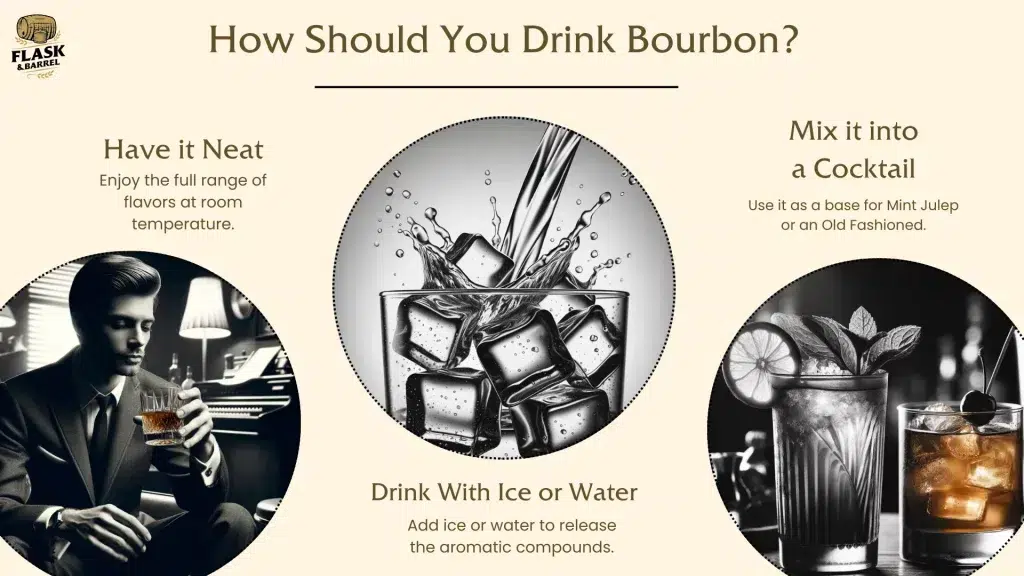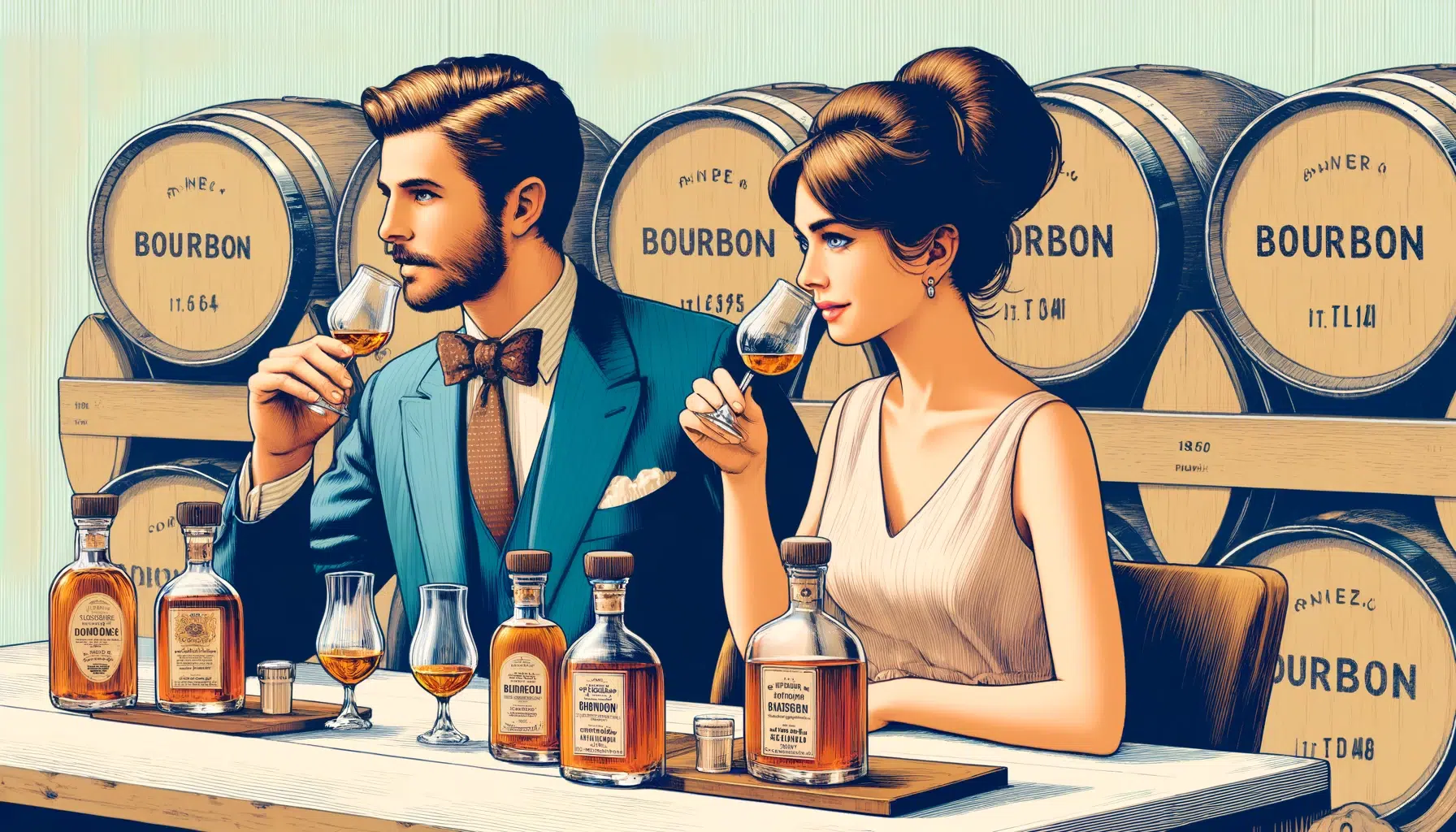Bourbon, often heralded as the crown jewel of American spirits, boasts a rich heritage and complexity that rivals its international whiskey counterparts. It distinguishes itself with a robust character and a versatility that resonates with both connoisseurs and casual drinkers alike. This distinctive spirit is celebrated for its depth, offering a tapestry of flavors that range from sweet and smooth to bold and spicy.
The essence of bourbon’s identity lies in its unique production process and the legal standards that define it, setting a high bar for quality and authenticity. Central to bourbon’s appeal are its primary styles: Straight Bourbon, Kentucky Bourbon, and Small Batch Bourbon, each presenting its own profile of flavors and nuances. Additionally, the category of Cask Strength Bourbon emerges, appealing to those seeking an unadulterated and potent whiskey experience.
Delving deeper, each style of bourbon reveals its own spectrum of tasting notes, methods of distillation, storied past, and pairing potentials with food. The subsequent sections will unfold these layers, offering a comprehensive exploration of what makes bourbon an esteemed and versatile spirit across the globe.
What Does Bourbon Taste Like?
Bourbon’s tastes like a symphony of complexity, marked by a rich tapestry of sweet, oaky, and spicy notes. At its core, bourbon tastes sweet, with hints of corn, which is the primary grain used in its production. This sweetness is beautifully complemented by the depth of vanilla and caramel, derived from aging in charred oak barrels.
The flavor profile is further enhanced by secondary notes such as fruitiness, nuttiness, and even subtle hints of chocolate, adding layers of complexity. The taste of bourbon can also vary significantly depending on factors such as the aging process, the distillation method, and the proof at which it is bottled. From the warm embrace of vanilla and caramel to the invigorating kick of spice, bourbon offers a diverse palette that caters to a wide range of preferences.

What are the Primary Flavors in Bourbon?
The primary flavors in bourbon are deeply influenced by its ingredients and aging process, creating a foundation of sweetness, oakiness, and vanilla and caramel notes. The sweetness primarily stems from the corn mash used in bourbon’s production, setting the stage for its inviting flavor profile. Oakiness comes from the charred oak barrels in which bourbon matures, imparting a rich and complex character.
Vanilla and caramel notes are a result of the aging process, where the spirit interacts with the wood, extracting these warm and comforting flavors. Together, these primary flavors define bourbon’s distinctive taste, offering a harmonious balance that is both robust and nuanced.
Sweetness
The sweetness in bourbon is a direct reflection of its corn-rich mash bill, providing a foundational sweetness that is both inviting and comforting. This characteristic sweetness sets bourbon apart, making it uniquely approachable and enjoyable.
Oakiness
Oakiness in bourbon comes from its aging process in charred oak barrels. This not only contributes to its complex flavor profile but also adds a distinctive richness and depth. The interaction between the spirit and the charred wood infuses bourbon with its notable oak character.
Vanilla and Caramel
The flavors of vanilla and caramel are hallmark notes in bourbon, derived from the aging process in oak barrels. As bourbon matures, it extracts these flavors from the wood, offering a warm, rich, and smooth taste. These notes are quintessential to bourbon, enhancing its complexity and appeal.
What are the Secondary Flavors in Bourbon?
Beyond the foundational sweetness, oakiness, and vanilla and caramel notes, bourbon unfolds a spectrum of secondary flavors that add depth and complexity. These include fruitiness, spiciness, nuttiness, and chocolate. Fruitiness can range from bright citrus to dark, ripe fruits, adding a fresh or rich layer to the bourbon’s profile.
Spiciness, often derived from the rye in the mash bill or the char level of the barrels, introduces a warm, invigorating kick. Nuttiness brings an earthy, rich dimension, while chocolate notes offer a luxurious, decadent depth. Together, these secondary flavors contribute to bourbon’s intricate tapestry, making each sip a discovery of new tastes and aromas.
Fruitiness
Fruitiness in bourbon introduces a spectrum of flavors, from the light zest of citrus to the deep, sweet notes of dark fruits. This variety adds a layer of freshness or richness, enhancing the bourbon’s overall complexity and appeal.
Spiciness
Spiciness in bourbon, often a result of the rye content in the mash bill or the char level of the barrels, delivers a warm and invigorating sensation. This spiciness complements the sweetness and oakiness, contributing to the spirit’s dynamic flavor profile.
Nuttiness
Nuttiness adds an earthy and rich dimension to bourbon, offering a subtle yet distinct counterpoint to its sweeter and spicier notes. This flavor component enriches the bourbon’s complexity, making each sip a multifaceted experience.
Chocolate
Chocolate notes in bourbon provide a luxurious and decadent depth, rounding out the spirit’s flavor profile with a smooth and rich finish. This hint of chocolate complements the vanilla and caramel, creating a sumptuous tasting experience.
How Does Bourbon Get its Flavor?
Bourbon acquires its distinctive flavor through a meticulous process that begins with its unique mash bill, predominantly made of corn, which imparts a foundational sweetness. The choice of grains, including rye or wheat alongside barley, further influences the flavor profile, introducing spiciness or softness. Aging in charred new oak barrels is critical, as the interaction between the spirit and the wood infuses the bourbon with complex flavors of vanilla, caramel, and oak.
The length of aging and the conditions of the storage environment also play significant roles, affecting the depth and intensity of the flavors. Additionally, the distillation process and the final proof at which the bourbon is bottled can alter its taste, making each bourbon expression unique. This combination of factors—grain selection, barrel aging, environmental conditions, and distillation choices—converges to create the rich tapestry of flavors that bourbon enthusiasts cherish.
How Does Aging, Distilling, and Mashing Affect Bourbon’s Flavor?
The flavor of bourbon is significantly shaped by three key processes: aging, distilling, and mashing. Mashing determines the initial flavor profile, with the specific mix of grains, predominantly corn, setting the stage for sweetness and the potential for spicy or soft notes depending on the use of rye or wheat. Distilling influences the concentration and purity of flavors, where the method and equipment used can either enhance or subdue certain taste elements.
Finally, aging is perhaps the most critical factor; as the bourbon matures in charred oak barrels, it undergoes a transformation, extracting vanillin, tannins, and other compounds from the wood, which contribute to the complex flavors of vanilla, caramel, and oak. The duration of aging and the conditions within the aging environment, such as temperature and humidity, further affect the rate of evaporation and oxidation, deepening the bourbon’s flavor and character. Together, these processes intertwine to craft the bourbon’s distinctive taste, making each batch a unique expression of its ingredients and production journey.
How Does Proof Affect Bourbon’s Flavor?
The proof at which bourbon is bottled plays a pivotal role in shaping its flavor profile. High-proof bourbons often deliver a more intense and robust flavor experience, with a pronounced warmth and depth that appeals to those who appreciate a bolder taste. The higher alcohol content can amplify the inherent flavors of the bourbon, making the sweet, spicy, and woody notes more pronounced.
On the other hand, low proof bourbons tend to offer a smoother and more mellow tasting experience, where the subtleties of flavor, such as vanilla, caramel, and fruit notes, can shine through without being overshadowed by the alcohol’s heat. The proof not only affects the sensory experience of drinking bourbon but also influences how it interacts with other ingredients in cocktails, making it a crucial consideration for both distillers and consumers.

High Proof
High proof bourbon, typically bottled at a higher alcohol content, offers a bold and intense flavor profile. This increased concentration of alcohol enhances the bourbon’s inherent characteristics, making its sweet, spicy, and oaky notes more pronounced. The warmth and depth provided by high-proof bourbon appeal to those seeking a richer, more robust tasting experience.
Low Proof
Low proof bourbon, on the other hand, is characterized by a smoother, more mellow flavor. The lower alcohol content allows the subtler notes of vanilla, caramel, and fruit to emerge, providing a more nuanced and approachable taste. Low proof bourbon is often favored for its gentleness, making it an excellent choice for sipping neat or in cocktails where the delicate flavors can be appreciated fully.
Does Bourbon Taste Better Mixed with Other Drinks?
Whether bourbon tastes better mixed with other drinks is largely subjective and depends on personal preference. For some wondering what to mix with bourbon, the complexity and richness of bourbon are best appreciated neat or with a splash of water to open up its flavors. However, bourbon’s versatility makes it an excellent base for cocktails, where its depth of flavor can complement and be enhanced by other ingredients.
Classic cocktails like the Old Fashioned and Mint Julep showcase bourbon’s ability to blend harmoniously with sweeteners, bitters, and fresh herbs, creating a balanced and enjoyable drink. Ultimately, the decision to enjoy bourbon mixed or straight rests with the drinker, with both methods offering unique ways to experience this storied spirit.
What Food Tastes Good with Bourbon?
Pairing food with bourbon opens a world of culinary delights, thanks to bourbon’s rich and diverse flavor profile. Foods that complement bourbon tend to have either a sweet, smoky, or savory character. Barbecue dishes, with their smoky sweetness, naturally harmonize with the caramel and vanilla notes of bourbon.

Dark chocolate desserts enhance bourbon’s inherent richness and can bring out its subtle chocolate and nutty undertones. For a savory pairing, cheeses, especially aged varieties like cheddar or gouda, create a delightful contrast with bourbon’s sweetness, while spiced nuts or cured meats can highlight its spiciness and complexity. The key to successful bourbon and food pairings lies in balancing flavors, ensuring that neither the bourbon nor the food overwhelms the other, but rather, they enhance one another’s best qualities.
Does Bourbon Lose its Taste Over Time?
Bourbon, once bottled, maintains its flavor profile and does not undergo significant changes in taste over time if stored properly. Unlike wine, which can evolve and mature in the bottle, bourbon’s aging process halts once it leaves the barrel and is sealed. Proper storage conditions—away from direct sunlight, at a stable temperature, and with the bottle standing upright to minimize cork contact—can preserve a bourbon’s taste for years.
However, if a bottle is opened, exposure to air can gradually alter its character, leading to potential oxidation which might slightly mellow its flavors. Therefore, while bourbon doesn’t inherently lose its taste over time, its preservation relies on careful handling and storage post-opening.
How Does The Taste of Bourbon Compare to Other Spirits?
Bourbon stands out in the world of spirits with its unique flavor profile, deeply rooted in its specific production process and ingredients. Compared to Scotch, which often carries a smoky peat flavor from its malt drying process, bourbon’s sweetness and richness from corn and new charred oak aging are distinct. Irish Whiskey, typically smoother and lighter, lacks the robustness and deep vanilla and caramel notes that are bourbon’s hallmark.
Japanese Whisky, known for its precision and balance, can mirror some of bourbon’s characteristics due to similar distillation practices, but it often leans towards a subtler and more refined flavor profile. Each spirit offers a different experience, with bourbon being celebrated for its boldness, warmth, and complexity, making it a favorite among those who appreciate a rich, full-bodied taste.

The Taste of Bourbon vs. Scotch
Bourbon and Scotch whiskies offer distinctly different taste experiences due to their unique production methods and geographic influences. Bourbon, with its mandatory corn-based mash, exudes a sweeter, fuller flavor profile with notes of vanilla, caramel, and oak. Scotch, particularly single malt Scotch, is known for its smoky peatiness, a result of the malt drying process, alongside a spectrum of flavors ranging from fruity to earthy, depending on the region of Scotland it’s produced in.
The Taste of Bourbon vs. Irish Whiskey
When comparing bourbon to Irish whiskey, the most notable difference lies in their smoothness and flavor intensity. Irish whiskey, typically triple-distilled and made from a mix of malted and unmalted barley, presents a lighter, smoother drinking experience. It often carries hints of fruit, vanilla, and a subtle graininess.
Bourbon, in contrast, boasts a more robust and richer flavor due to its higher corn content and aging in new charred oak barrels, highlighting deep caramel and vanilla notes.
The Taste of Bourbon vs. Japanese Whisky
Japanese whisky and bourbon share some similarities in their approach to distillation and aging, often resulting in a comparable smoothness and richness. However, Japanese whisky tends to lean towards a more refined and delicate profile, with a balance of sweet and floral notes, sometimes mimicking the peaty character of Scotch. Bourbon, with its bold and complex flavor profile, driven by its specific grain bill and aging process, offers a distinctly different experience, marked by its characteristic sweetness and depth from the oak aging process.
How Should You Drink Bourbon?
Want to know how to drink bourbon? It’s a personal experience that varies widely among enthusiasts, with several methods to appreciate its rich flavors fully. Some prefer drinking bourbon neat, allowing the unadulterated spirit to express its full range of flavors at room temperature. Others opt for a splash of water or an ice cube, which can open up the bourbon, releasing more aromatic compounds and slightly lowering the proof for a smoother sip.

For those who enjoy cocktails, bourbon serves as a versatile base in classics like the Old Fashioned and Mint Julep, where its complex flavors are complemented and enhanced by other ingredients. Ultimately, the best way to drink bourbon is the way that most satisfies your taste preferences, whether savoring it slowly to appreciate its nuances or enjoying it as part of a crafted cocktail.





